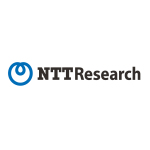Paper in Science Robotics presents ML application that efficiently delivers high-performance design and 2x swimming efficiency compared to rays developed biomimetically
News Highlights:
- Application of machine-learning direct optimization (ML-DO) demonstrates superior design approach and improved swimming speeds and efficiency of biohybrid rays
- Scientists target future cases of biohybrid robotics for remote sensing, drug delivery, aiding in understanding of organ biofabrication, and more
- Research leverages 2022 joint research agreement between NTT Research and Harvard University
NTT Research and Harvard Scientists Optimize Biohybrid Ray Development with Machine Learning
NTT Research Contact:
Chris Shaw
Chief Marketing Officer
NTT Research
+1-312-888-5412
chris.shaw@ntt-research.com
Media Contact:
Nick Gibiser
Wireside Communications®
For NTT Research
+1-804-500-6660
ngibiser@wireside.com
NTT Research, Inc., a division of NTT (TYO:9432), and the Harvard John A. Paulson School of Engineering and Applied Sciences (SEAS) announced the publication of research showing an application of machine-learning directed optimization (ML-DO) that efficiently searches for high-performance design configurations in the context of biohybrid robots. Applying a machine learning approach, the researchers created mini biohybrid rays made of cardiomyocytes (heart muscle cells) and rubber with a wingspan of about 10 mm that are approximately two times more efficient at swimming than those recently developed under a conventional biomimetic approach.
A team led by Harvard SEAS Postdoctoral Fellow Dr. John Zimmerman and including NTT Research Medical and Health Informatics Scientist Ryoma Ishii, Harvard SEAS Tarr Family Professor of Bioengineering and Applied Physics Kevin Kit Parker, and members of the Harvard SEAS Disease Biophysics Group led by Parker demonstrated this research in a new paper published in Science Robotics titled, “Bioinspired Design of a Tissue Engineered Ray with Machine Learning.”
“This research seeks to answer a fundamental question in the development of biohybrid robots, in this case the marine ray: How do we select fin geometries to operate under novel working environments while preserving natural scaling laws in terms of swimming speed and efficiency,” said Ishii, who also works as a visiting scientist for Harvard University. “Our research indicates the application of ML-DO, inspired by protein engineering, offers a more efficient and less computationally intensive path forward in automating the creation of muscular structure-function relationships.”
Limitations of the Biomimetic Approach
In biomimetic design, the conventional approach to biohybrids, engineers form functional devices by recreating existing biological structures. That approach, however, has limits. For biohybrid lifeforms that resemble batoid fishes (skates and rays), for example, there is a wide range of natural aspect ratios and fin morphologies. Which ones do you mimic? Also, biomimetics may neglect the natural biomechanical and hydrodynamic forces that govern how fast an organism can swim based on its size and body kinematics, leading to inefficient muscle mass and limited swimming speeds.
In that light, the motivating question in this study became: How to select fin geometries that operate under novel working environments while preserving natural scaling laws in terms of swimming speed and efficiency?
The Design Breakthroughs of Machine Learning
The multi-disciplinary and iterative nature of the problem required computationally intensive modeling, but the team believed that directed optimization by machine learning (ML-DO) would enable an efficient search for fin designs that maximized their relative swimming speeds. They based their hypothesis in part on a trial function that demonstrated an approximately 40 percent improvement of ML-DO over other leading methods in recognizing known high-rank sequences. Testing the assumption involved three steps: 1) developing an algorithm for expressing a multitude of different fin geometries; 2) describing a generalized ML-DO approach for searching within a large discontinuous configuration space; and 3) using this methodology to identify biohybrid fin geometries for high-performance swimming with smooth and orderly flow.
The ML-DO-driven results included a quantitative exploration of fin structure-function relationships and reconstruction of general trends in open-sea batoid morphology, as well as a winning design: Fins with large aspect ratios and fine tapered tips, which preserved their utility across multiple length-scales of swimming. On that basis, the team built biohybrid mini-rays out of engineered cardiac muscle tissue, which were capable of self-propelled swimming at the millimeter length scale and demonstrated improved swimming efficiencies approximately two times greater than observed in previous biomimetic designs.
Looking Ahead
While promising, researchers note that additional work is needed to completely match natural scaling laws. While the devices presented in this study demonstrated greater efficiency than other recent biomimetic designs, they were still slightly less efficient on average than naturally occurring marine lifeforms.
In the future, researchers expect to continue the development of biohybrid robotics for use cases including remote sensors, probes for dangerous working environments and as therapeutic delivery vehicles. Researchers believe that the ML-DO-informed approach better mimics the selective pressures of evolution, enabling them to better understand how biological tissues are shaped—both in a healthy physiology as well as the maladaptive pathophysiology of disease. Additionally, this research advances scientific understanding of 3D organ biofabrication, such as a biohybrid heart.
“The Harvard Biophysics Group entered into a joint research agreement with NTT Research two years ago aiming to fundamentally interrogate our understanding of cardiac physiology, with an eye towards advancing the development of biohybrid devices, including biohybrid robotics and biohybrid human heart,” Parker said. “This paper indicates the positive progress our shared research has achieved so far, and I am excited to see what the future of our collaboration has in store.”
In 2022, NTT Research and Harvard SEAS announced a three-year joint research agreement to engineer a model of the human heart, study fundamental laws of muscular pumps and apply joint findings to the development of a cardiovascular bio digital twin model.
About NTT Research
NTT Research opened its offices in July 2019 as a new Silicon Valley startup to conduct basic research and advance technologies that promote positive change for humankind. Currently, three labs are housed at NTT Research facilities in Sunnyvale: the Physics and Informatics (PHI) Lab, the Cryptography and Information Security (CIS) Lab, and the Medical and Health Informatics (MEI) Lab. The organization aims to advance science in three areas: 1) quantum information, neuroscience and photonics; 2) cryptographic and information security; and 3) medical and health informatics. NTT Research is part of NTT, a global technology and business solutions provider with an annual R&D budget of $3.6 billion.
About the Harvard John A. Paulson School of Engineering and Applied Sciences
The Harvard John A. Paulson School of Engineering and Applied Sciences serves as the connector and integrator of Harvard's teaching and research efforts in engineering, applied sciences, and technology. Through collaboration with researchers from all parts of Harvard, other universities, and corporate and foundational partners, we bring discovery and innovation directly to bear on improving human life and society. For more information, visit: http://seas.harvard.edu.
NTT and the NTT logo are registered trademarks or trademarks of NIPPON TELEGRAPH AND TELEPHONE CORPORATION and/or its affiliates. All other referenced product names are trademarks of their respective owners. © 2024 NIPPON TELEGRAPH AND TELEPHONE CORPORATION
View source version on businesswire.com: https://www.businesswire.com/news/home/20250212613779/en/










